Saving lost species: Scientists are resurrecting the extinct Tasmanian Tiger
The Tasmanian tiger roamed in Australia and on the island of New Guinea before dying out about 85 years ago.

[Sept. 26, 2023: Staff Writer, The Brighter Side of News]
Extinct Tasmanian tiger brought to life in colour footage. The Tasmanian tiger roamed in Australia and on the island of New Guinea before dying out about 85 years ago. (CREDIT: Creative Commons)
In what can be best described as a tango between science, nature, and human intervention, a revolutionary endeavor is underfoot.
The objective? Breathing life into an extinct species—specifically, the mysterious Tasmanian Tiger, also known as Thylacine—a marsupial predator that once thrived in the lush landscapes of Tasmania and New Guinea.
The thylacine's story is one colored with fascination and regret. These carnivorous marsupials once roamed the islands of New Guinea and Tasmania. Although they vanished from New Guinea millennia ago, their story continued on the southeastern Australian island. As its name suggests, the Tasmanian Tiger was an icon of Tasmania, an emblem of the region's diverse wildlife.
Related News
However, during the 19th century, human interference cast a shadow on their survival. Labelled a threat to local livestock, a prolonged period of bounty hunting took a devastating toll on their population, driving them to the verge of extinction. This culminated in the death of the last known thylacine in captivity in 1936—a sad epitaph to human predation.
While there have been whispers and speculations—some even equating their potential existence to the legends of Sasquatch—no confirmed specimen has surfaced since their supposed extinction.
RNA: Nature's Time Capsule
Determined to potentially glimpse the thylacine once more, a groundbreaking approach has emerged. Scientists are now considering creating a Tasmanian Tiger from scratch. But how?
Enter RNA sequencing—a technique akin to reading the pages of a book long thought lost. As detailed in a recent publication in the prestigious journal Genome Research, a 132-year-old thylacine specimen provided the foundational material for this ambitious endeavor. From this specimen, stored at mere room temperature, millions of RNA sequences have been isolated, offering scientists a deep dive into the creature’s genetic makeup and its bodily protein formations.
The essence of the specimen—the very transcriptome that captures an organism's expressed genes—was extracted from the thylacine’s skin and skeletal muscle tissues. While the genome stands as the entirety of the organism's hereditary information, the transcriptome is the functional unit, essentially the RNA that expresses this information.
Scientists are making the animal from scratch using RNA sequenced from a 132-year-old specimen. (CREDIT: Universal History Archive - Getty Images)
Intriguingly, sequences extracted from the muscles highlighted their functionality, showcasing how they stretch and contract. Concurrently, skin sequences revealed the intricacies of keratin formation, the fundamental protein responsible for hair, nails, and the outer skin layer.
Emilio Mármol, the study's lead author and an esteemed computational biologist at the SciLifeLab in Sweden, commented, “Resurrecting the Tasmanian tiger or the woolly mammoth is not a trivial task. It will necessitate a profound understanding of both the genome and transcriptome regulation of such iconic species. Only now is this information beginning to unveil itself."
Two extinct Thylacines or Tasmanian tigers. (CREDIT: Deposit photos)
While the Tasmanian Tiger stands at the forefront of this scientific saga, the implications extend much further. Prior to this, the oldest RNA extraction hailed from a 14,300-year-old wolf preserved in permafrost. This recent achievement with the thylacine, obtained from a sample in the Stockholm Natural History Museum, paves the way for the resurrection of various species lost to human-induced extinction.
Humanity's Redemption?
The scars humans have inflicted upon Earth's biodiversity are profound and undeniable. Yet, with science as an ally, there's a glimmer of hope. While many technical and ethical challenges lie ahead, this research symbolizes a potential way to reconcile with nature.
As we stand at this crossroads, one thing is certain: Science is tirelessly working to mend the damage, and perhaps, in the not-so-distant future, we might witness the return of creatures we once thought lost forever.
For more scientific news stories check out our Innovation News section at The Brighter Side of News.
Note: Materials provided above by the The Brighter Side of News. Content may be edited for style and length.
Like these kind of feel good stories? Get the Brighter Side of News' newsletter.



